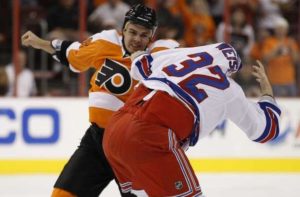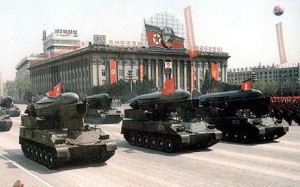by Robert Latin and Tim LaRocco
The National Hockey League tragically lost three members of its family this past off-season. The untimely deaths of three “enforcers” — Derek Boogard, Rick Rypien, and Wade Belak — as well as the NHL’s continuing problem with concussions has rejuvenated criticism of the role of enforcers in hockey.
Most enforcers are deficient in most areas of the game required to maintain longevity in the profession: skating, goal scoring ability, and defensive awareness. However, most teams in the NHL carry an enforcer on their roster. If the name of the game is to score more goals than you allow, why are such enforcers kept around when they appear to provide very little to the desired outcome?
 The answer may be found in deterrence theory. The theory is quite simple: in order for a country to deter an attack from another country, it must demonstrate the necessary power and capability to retaliate with unacceptable punishment. This was the military strategy used by the United States and the Soviet Union during the Cold War in an attempt to prevent nuclear Armageddon.
The answer may be found in deterrence theory. The theory is quite simple: in order for a country to deter an attack from another country, it must demonstrate the necessary power and capability to retaliate with unacceptable punishment. This was the military strategy used by the United States and the Soviet Union during the Cold War in an attempt to prevent nuclear Armageddon.
Just as a state might reconsider an attack if its adversary has the potential to reciprocate, the players on a hockey team might amend their behavior during the game if they know an enforcer is waiting with clenched fists on the opposing bench. A player might think twice about taking liberties with an opposing team’s star player knowing that the threat of the enforcer is hovering in the background. In other words, the threat and occasional use of violence by enforcers likely reduces the overall level of violence and injury in hockey.
Current international affairs provides an appropriate juxtaposition. Would the United States provoke a conflict with a nuclear armed state, such as North Korea, the way it has in the past with non-nuclear states? It is highly unlikely. In the practice of foreign policy, state’s need such a threat perception as well in order to provide a check on powerful nations which may have nefarious global ambitions.
At first glance, it would make sense to get rid of enforcers in the NHL. Some would argue that fighting is barbaric and causes injuries. But if you are an owner of a hockey team, you want to protect your investments. The enforcer deterrent prevents star players from being taken advantage of, providing them with a safety mechanism. No one can thwart injuries in a contact sport such as hockey, but enforcers can have an effect which curtails instances of serious injuries intentionally directed at star players.
 Indeed, this was the case during the dynasty years of the New York Islanders and Edmonton Oilers in the 1980s. Their respective tough guys were an intricate part of their successes. On Long Island, Clarke Gillies provided the necessary protection for line mates Mike Bossy and Bryan Trottier. Similarly, Edmonton’s Dave Semenko, and later Marty McSorely, did the same for hockey great Wayne Gretzky, allowing him more room on the ice to create offense. Opposing players knew that getting too close for comfort to a team’s star player would result in an intervention from the enforcer.
Indeed, this was the case during the dynasty years of the New York Islanders and Edmonton Oilers in the 1980s. Their respective tough guys were an intricate part of their successes. On Long Island, Clarke Gillies provided the necessary protection for line mates Mike Bossy and Bryan Trottier. Similarly, Edmonton’s Dave Semenko, and later Marty McSorely, did the same for hockey great Wayne Gretzky, allowing him more room on the ice to create offense. Opposing players knew that getting too close for comfort to a team’s star player would result in an intervention from the enforcer.
The NHL might be tempted to move away from the use of enforcers. But, the recent wave of injuries to marquee skill players and deterrence theory suggest that the role of the enforcer needs to be regulated, not repressed. In both international affairs and NHL hockey, the old maxim of the Roman Empire had it right: “to achieve peace, prepare for war.”